Making "The Game of Life"
An in-depth look at the design and research behind the interactive dance work.
 Discussion during rehearsal break. Centre national de danse contemporaine. Angers, France.
Discussion during rehearsal break. Centre national de danse contemporaine. Angers, France.“The Game of Life” is a live interactive work performed by three dancers and three musicians. The piece is organized around modules of choreography and music which are sequenced in real time onstage, according to a set of predetermined rules and interrelations between the performers. Read more about the production here.
Table of Contents
Overview
📽️ An excerpt from the dress rehearsal
tl;dr:
I joined a contemporary dance company to work on a new production that premiered in November 2022. I performed two distinct roles: interaction designer and researcher.
Objectives
- Interaction design: Develop interactive systems that would allow the work to be performed in a generative, rule-based structure
- Research: Examine how design practice is carried out within artistic productions.
Design highlights:
- Collaborated closely with the creators: two choreographers and a composer.
- Co-designed four interactive modules that utilized biosignal acquisition, multimodal feedback, wireless networking, and interfacing with theater audio and lighting systems.
- Engineered, implemented, and tested all of the technical systems.
Research highlights:
- Collected heterogeneous qualitative research data through two residencies where the work was created.
- Interviewed choreographers and performers to capture their insights and experiences about the creation and technical design process.
- Thematic analysis generated high-level themes around design for creative productions.
- Presented findings at the 2023 ACM Designing Interactive Systems (DIS) Conference.
I. Background
I joined Le principe d’incertitude, the French dance company of choreographers Liz Santoro and Pierre Godard, to work on this piece in the fall of 2022 after my arrival in Paris for a 2-year postdoc working on a project entitled “Living Archive: Interactive Documentation of Dance”, at the ex)situ laboratory of the Université Paris-Saclay under the supervision of Sarah Fdili Alaoui. The initial plan was to join the crew to conduct research on the development of a new technology-mediated dance piece. However, an initial discussion revealed that they were also in need of a designer and technician to help them develop interactive systems they envisioned for the piece, so I took up dual roles of researcher and interaction designer.
My involvement with the creation took place over three main periods leading up to the premiere in November 2022: a two-week preliminary planning stage, and two two-week residencies leading up to the premiere. “The Game of Life” has been performed multiple times around France, with additional dates scheduled for 2024.
II: Interaction Design
Stage 1: Pre-planning.
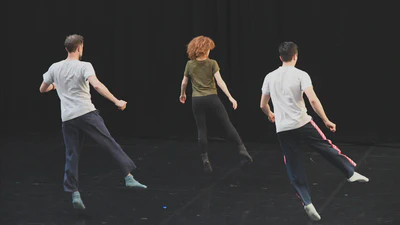
I joined Santoro and Godard at the studio and at their home, where they explained how they envisioned the piece being performed, and some early ideas they had for implementing interactive technologies that would permit the sequencing to be performed in a live, generative way. We chose to focus our attention on the following aspects:
- Exploring and implementing feedback loops via biosignal sensing, between dancers and musicians, and between audience and performers.
- Developing a central control system to encompass and enforce the “rules” of the composition, and integrate with custom theater lighting to provide realtime onstage cuing for the performers.
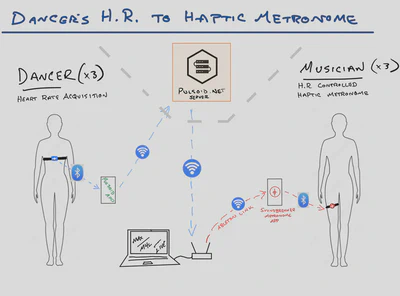
Stage 2: First residency
I arrived at the residency with some early proof-of-concept designs to try out. Working closely with Godard and composer Pierre-Yves Macé, I iterated and refined system designs, testing them on the spot in daily afternoon rehearsals. By the end of the residency, two main modules were implemented: a basic control hub and lighting interface, and a feedback system that mapped the dancers’ heart rates to the evolving musical tempo. An audience-performer feedback system was also developed and tested, but ultimately discarded as it was unreliable and didn’t quite fit the aesthetics of the piece. During this time, the dance and music creation was still very much in development, with changes and progress made every day.
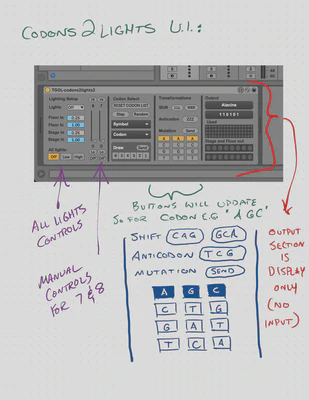
Stage 3: Second residency
During the second residency, the control-lighting and heart rate-tempo modules continued to be refined as the choreography came together into finished form. Two additional modules were also developed. The first, developed in coordination with composer Macé’s evolving musical composition, was a communication bridge deliver realtime information and cues to a separate audio computer that performed an ever-growing series of processes, sampling and modulating the sounds of the live instruments and adding additional layers of sound synchronized to with the unfolding onstage performance. The last module, delivered just the day before the premiere, took full control of the entire theater lighting and automated it to the generative sequences of the dance.
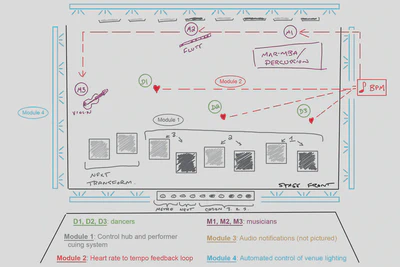
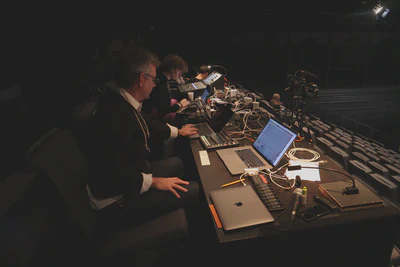
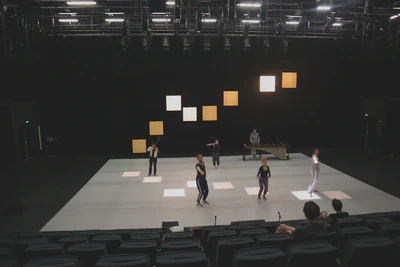
III: Auto-ethnographic research on dance technology design
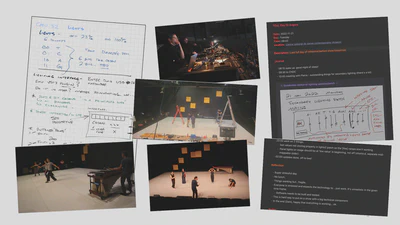
In my role as researcher, I documented the creation process during the residences through notes and sketches, photos and videos, and a research journal. Through these media, I recorded my own daily activities and those of the team, and made observations and reflections on the entire process as well as my own roles. I used these sources to assemble a design story that provides my perspective on the residencies and the design process, one that I characterize through the lens of design occurring within an artistic creation.
I augmented my own perspective by conducting conversational interviews with the choreographers and performers. We conducted a thematic analysis of the transcribed interviews, through which we identified nine themes divided into two categories: a) “the realities of a constrained and messy process, and b) “trusting technology to become an invisible scaffolding for an embodied performance”.
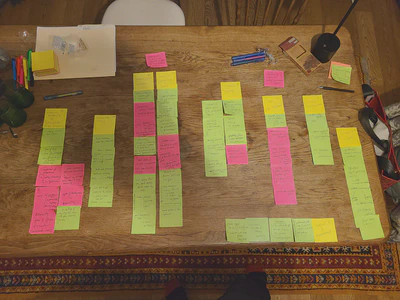
As mentioned, I presented the research at the 2023 ACM Designing Interactive Systems conference (DIS) in Pittsburgh, USA on behalf of my coauthors: Sarah Fdili Alaoui, Liz Santoro, and Pierre Godard. In our paper, we characterize research occuring within artistic creation as messy and situated, defined by overlapping roles and idiosyncratic practices. We consider related work in design research, especially related to artistic practice, and find Steve Benford and colleagues’ “Performance-Led Research in the Wild”1 to be a particularly useful model for understanding artist-led research. We suggest that our findings can extend this even farther to include the dynamic roles and activities that occur within and between artistic creation and design. Further, we propose that our work can serve as an exemplar for other design contexts that may be resistant to formal methods and require flexible approaches.
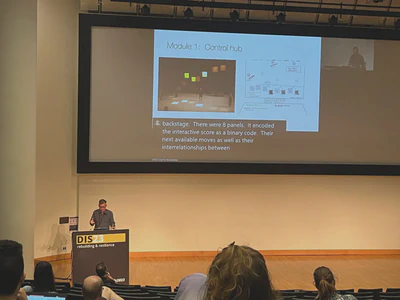
IV: Epilogue: Human-Machine Interaction Workshop: Inventing new “Games of Life”
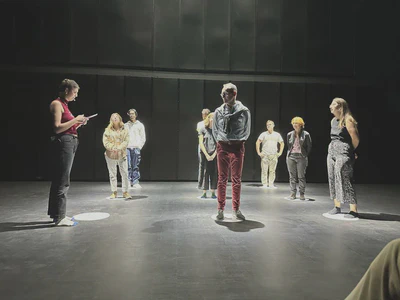
In Fall 2023, Fdili Alaoui and I organized a week-long workshop on Human-Machine Interaction that is part of the École Normale Supérieure (ENS) Paris-Saclay Research-Creation Diploma curriculum. We invited Santoro and Godard as guest instructors, and proposed for the students to create and perform their own interactive performance works, based on four principles of interaction that inspired “The Game of Life”:
- Generative score (initial conditions, rules, variability from one performance to the other)
- Presence of feedback loops (cybernetic, self-regulating systems)
- Interdependency between performers (the state of each performer influences that of the others, as in an ecosystem)
- Shared score for dance and music (common rules and codes for both media)
The class assembled into three groups and created three diverse interactive works that were performed for a packed house at the end of the week.
📽️ Final group performance from the ARRC Human-Machine Workshop: Recorded sounds of water being manipulated are processed according to the captured movements of a dancer, who in turn is responding to the modulated sounds of the water.
📽️ Final group performance from the ARRC Human-Machine Workshop: A sequencer that formulates sentences out of a corpus of words, which instructs the dancers to perform specific movements.
Steve Benford, Chris Greenhalgh, Andy Crabtree, Martin Flintham, Brendan Walker, Joe Marshall, Boriana Koleva, Stefan Rennick Egglestone, Gabriella Giannachi, Matt Adams, Nick Tandavanitj, and Ju Row Farr. 2013. “Performance-Led Research in the Wild.” ACM Transactions on Computer-Human Interaction. 20, 3 (July 2013), 14:1–14:22. https://doi.org/10.1145/2491500.2491502 ↩︎